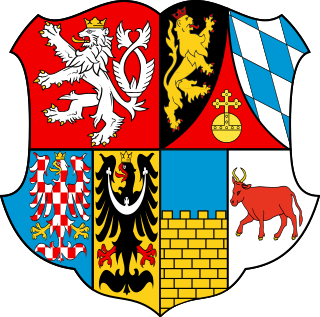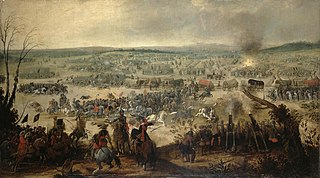
The Battle of White Mountain was an important battle in the early stages of the Thirty Years' War.

Ambrogio Spinola Doria, 1st Marquess of The Balbases, GE, KOGF, KOS was an Italian condottiero and nobleman of the Republic of Genoa, who served for the Spanish crown and won a number of important battles. He is often called "Ambrosio" by Spanish speaking people and is considered one of the greatest military commanders of his time and in the history of the Spanish army. His military achievements earned him the title of Marquess of Balbases in the Spanish peerage, as well as the Order of the Golden Fleece and Order of Santiago.

The Catholic League was a coalition of Catholic states of the Holy Roman Empire formed 10 July 1609. While initially formed as a confederation to act politically to negotiate issues vis-à-vis the Protestant Union, modelled on the more intransigent ultra-Catholic French Catholic League (1576), it was subsequently concluded as a military alliance "for the defence of the Catholic religion and peace within the Empire".

The Battle of Fleurus of August 29, 1622 was fought in the Spanish Netherlands between a Spanish army, and the Protestant forces of Ernst von Mansfeld and Christian of Brunswick during the Eighty Years' War and Thirty Years' War. The bloody struggle left the Protestants mangled and the Spanish masters of the field, but unable to block the enemy's march.

The Franco-Spanish War (1635–1659) was a military conflict that was the result of French involvement in the Thirty Years' War. After the German allies of Sweden were forced to seek terms with the Holy Roman Empire, the French first minister, Cardinal Richelieu, declared war on Spain because French territory was surrounded by Habsburg territories. The conflict was a continuation of the aims of the War of the Mantuan Succession (1628–31) in which France invaded northern Italy to take possession of territory claimed by the Spanish Habsburgs. Though some minor territorial gains were made by France, the Franco-Spanish War ended inconclusively in 1659 with the Treaty of the Pyrenees.

Diego Mexía Felípez de Guzmán y Dávila (1580–1655), Viscount of Butarque and first Marquis of Leganés, was a Spanish politician and army commander.
Antonio Fernández de Córdoba y Cardona, 5th Duke of Sessa, was a Spanish nobleman. He held the titles of Duke of Sessa, Duke of Soma, and Duke of Baena, among others.

Gonzalo II Fernández de Córdoba, 3rd duke of Sessa, was the grandson of a Viceroy of Naples, Gonzalo Fernández de Córdoba, 1st duke of Sessa. He was twice a Governor of the Duchy of Milan, 1554–1560, Knight 217 of the Order of the Golden Fleece in 1555, and was awarded the title of 1st duke of Baena by King Philip II of Spain on 19 August 1566. In 1552 he sold his title of 3rd duke of Andria to Fabrizio Carafa, count of Rufo.

The Siege of Heidelberg or the Imperial-Spanish capture of Heildelberg took place from 23 July to 19 September 1622, at Heidelberg, Electorate of the Palatinate, between the Imperial-Spanish army led by Johan Tzerclaes, Count of Tilly and Don Gonzalo Fernández de Córdoba against the Anglo-Protestant forces of Frederick V, Elector Palatine, commanded by Sir Gerard Herbert and Sir Horace Vere during the Palatinate campaign, in the context of the Thirty Years' War. On 16 September the city of Heidelberg was taken by storm, and the Heidelberg Castle surrendered three days later to the Imperial and Spanish forces.

The Capture of Mannheim took place on 2 November 1622, by the Imperial-Spanish army commanded by Johan Tzerclaes, Count of Tilly against the Protestant troops under the Englishman Sir Horace Vere during the Thirty Years' War.

The Palatinate Campaign, or the Spanish conquest of the Palatinate, was a series of sieges, battles and conquests during the Palatinate Phase of the Thirty Years' War, carried out by the Army of Flanders under Don Ambrosio Spinola, and the Imperial-Spanish troops under Johann Tserclaes, Count of Tilly and Don Gonzalo de Córdoba. The Habsburg forces took advantage of Frederick of the Palatinate's predicament by invading the German Protestant Palatinate in 1620 and conquering it by the end of 1622.

The Siege of Bad Kreuznach or the Spanish capture of Bad Kreuznach took place on 10 September 1620, in Bad Kreuznach in the Electorate of the Palatinate, where the Army of Flanders, led by the spanish Don Ambrosio Spinola, conquered the troops of Frederick V, Elector of the Palatinate, during the Palatinate campaign of the Thirty Years' War. The Army of Flanders was a multinational army in the service of the kings of Spain that was based in the Netherlands during the 16th to 18th centuries. Spinola's troops stormed Bad Kreuznach and its garrison surrendered. Later the town was freed on an oath not to rebel against the Holy Roman Empire.

The Capture of Oppenheim or the Spanish capture of Oppenheim took place on 14 September 1620, at Oppenheim, Electorate of the Palatinate, between the Spanish army commanded by Don Ambrosio Spinola, Marquis of the Balbases, against the forces of the Electoral Palatinate led by Joachim Ernst, Margrave of Brandenburg-Ansbach, during the Palatinate campaign, in the context of the Thirty Years' War. The Spanish troops under Spinola, with a great maneuver of distraction over Worms, deceived the Protestant army of Joachim Ernst, and captured the important town of Oppenheim without too much difficulty, causing a severe blow to the Protestant forces.

The Capture of Bacharach took place on 1 October 1620 at Bacharach, Electorate of the Palatinate. The conflict was between the Spanish forces commanded by Don Gonzalo Fernández de Córdoba and the Protestant forces of Frederick V, Elector Palatine, during the Palatinate campaign in the context of the Thirty Years' War. After a quick start of the invasion of states of Frederick V, proclaimed King of Bohemia, the operations slowed in mid-September, after the Capture of Oppenheim. Don Ambrosio Spinola, the Spanish general in command, assessed at a council of war the choice between undertaking the siege of Heidelberg or, secondarily, the town of Bacharach. The Spanish officers decided to take Bacharach due to the small number of Frederick's scattered forces. On 1 October Córdoba captured Bacharach with a force of 2,500 soldiers, forcing the Anglo-German defenders to surrender.

Gil or Gilles De Haes (1597–1657), sometimes known as Guldehasius, was a Flemish soldier of the Eighty Years War, the Thirty Years War and the Cretan War (1645–69), who rose through the ranks to be a general.
The Siege of Frankenthal was a siege of the Palatinate campaign during the Thirty Years' War. A Spanish army under Gonzalo Fernández de Córdoba besieged the city and its mostly English garrison commanded by Horace Vere. The siege lasted from 1621 to March 20, 1623, when King James I ordered the city to surrender.





























